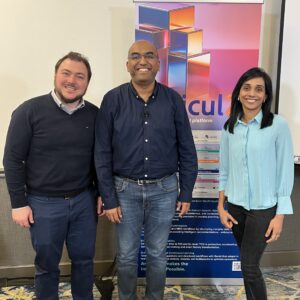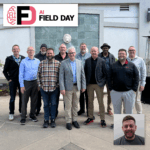|
|
 Renato Nascimento, Arun Subramaniyan, and Parvi Letha presented for Articul8 at AI Field Day 7 |
This Presentation date is October 30, 2025 at 10:30-12:00.
Presenters: Arun Subramaniyan, Parvi Letha, Renato Nascimento
In an era where every competitor uses the same base GenAI models, true differentiation is no longer just about access, it’s about uniqueness. At AI Field Day 7, Articul8 will present how we are building a future where each company (and each user) can amplify its own distinct intelligence. Not by layering more compute, but by engineering context, domain expertise, and autonomous reasoning.
Join Articul8’s Founder & CEO Arun Subramaniyan, Parvathi Letha (Head of Product Management), and Renato Nascimento (Head of Technology) in a 90-minute live session featuring:
- The vision behind hyper-personalization in GenAI
- A concise walkthrough of Articul8’s domain-specific full-stack architecture
- A live technical demo (interactive with delegates)
- Concrete examples of domain-specific models outperforming general-purpose models (yes, even GPT-5)
Expect to walk away with a clearer sense of what “context-driven, domain-specific GenAI” really means in practice, and how it’s not the next step, but the only step for truly enterprise-grade differentiated GenAI.
Why Uniqueness Defines the Future of Enterprise GenAl with Articul8
Watch on YouTube
Watch on Vimeo
At AI Field Day 7, Dr. Arun Subramaniyan, Founder and CEO of Articul8, presented a compelling vision of the future of enterprise generative AI (GenAI) centered on hyper-personalization and domain specificity. The talk addressed the evolution of AI accessibility, highlighting how general-purpose models have become commoditized, making it easier than ever to generate content but often sacrificing depth and context. Dr. Subramaniyan emphasized the limitations of relying purely on generic large language models (LLMs) for enterprise tasks, especially in specialized domains like healthcare, manufacturing, cybersecurity, and energy. Instead, Articul8 advocates for tailored solutions built using domain-specific models that can factor in both tacit knowledge and contextual nuances that general models may overlook or misinterpret.
Articul8’s technological strategy involves developing proprietary models specifically trained or fine-tuned with datasets relevant to particular industries. These models range in size from a few billion to several hundred billion parameters. They are not designed to be general-purpose but to perform specific tasks within domains such as thermodynamics, aerodynamics, and system diagnostics. Articul8 also builds task-specific models, such as those focused on table understanding in spreadsheets or parsing complex PDFs. These models are augmented with multi-model orchestration capabilities and metadata tagging to construct automated knowledge graphs, enabling richer semantic understanding without moving raw data—only metadata is transferred. This approach allows enterprises to retain control over data security, including air-gapped deployments, while benefiting from AI-powered insights.
Articul8’s platform architecture supports both on-premises and SaaS-based models, enabling flexibility in deployment. The platform can ingest unstructured data, apply semantic reasoning, and, using a combination of models and tools, generate agents and squads of agents that autonomously execute “missions” within enterprise workflows. This layered AI model architecture culminates in creating “digital twins,” which are dynamically updated representations of business systems for simulation and high-fidelity analysis. Demonstrating measurable performance gains, Articul8 benchmarked its energy domain model against state-of-the-art general-purpose models like LLaMA 3, GPT-4, and others, showing superior results across multiple task dimensions. The company maintains control of intellectual property in models unless customer data is involved in training, in which case the IP resides with the customer. This approach ensures scalability while maintaining rigorous standards for contextual accuracy, enterprise integration, and domain relevance.
Personnel: Arun Subramaniyan
Inside Articul8’s Domain-Specific Platform and Real-World ROl
Watch on YouTube
Watch on Vimeo
At AI Field Day 7, Parvathi Letha, Head of Product Management at Articul8, and Dr. Arun Subramaniyan, Founder and CEO of Articul8, presented the Articul8 platform, a secure, domain-specific generative AI solution tailored for high-value enterprise use cases. Parvathi detailed the architecture, beginning with its autonomous data perception functionality, which ingests and semantically connects structured and unstructured data—including PDFs, tables, images, and CAD drawings—into a living, schema-aware knowledge graph. This knowledge graph serves as the core institutional memory, continually evolving through user interactions, and supports auditability and traceability by tracking updates and allowing for corrective feedback, ensuring personalized and adaptive intelligence for each enterprise and user.
A cornerstone of Articul8’s approach is its agentic reasoning engine, which utilizes hundreds of domain- and task-specific agents. When a complex enterprise mission is received, the reasoning engine breaks it down into sub-missions and autonomously selects the most appropriate agent for each segment. This collaborative, context-aware architecture emulates expert teams, vastly accelerating tasks such as root cause analysis, compliance checks, and network troubleshooting, and supporting outcomes with fine-grained traceability. Articul8’s hyper-personalization goes further with adaptive user interfaces and the capability to create digital twins, allowing outputs and insights to reflect individual user decision styles and enterprise workflows. Domain-specific models span industries like semiconductor, aerospace, manufacturing, supply chain, and telco, with bespoke agents such as a highly specialized Verilog model for chip design and general-task agents for time series, table, and chart understanding.
For enterprise consumption, Articul8 supports multiple models: companies can subscribe to the full suite as a traditional enterprise software platform or deploy select agents a la carte via the AWS Marketplace, paying per API call for agents like LLM IQ, which benchmarks LLMs for specific use cases, or the Network Topology Agent, which digests network logs and diagrams to support troubleshooting. The platform’s industry-specific models are co-developed with partners such as the Electric Power Research Institute and leading aerospace firms, ensuring both robust data integration and expert validation. Articul8’s agent-of-agent architecture has been in production for more than two years and is already driving measurable ROI in semiconductor root cause analysis and CAD validation, reducing processing times from days to hours and delivering over 93 percent detection accuracy—while maintaining data control and auditability entirely within customer security perimeters.
Personnel: Arun Subramaniyan, Parvi Letha
The Technical Foundations of Articul8’s Agentic Al Platform
Watch on YouTube
Watch on Vimeo
Dr. Renato Nascimento, Head of Technology at Articul8, and Dr. Arun Subramaniyan, Founder and CEO, presented the technical architecture and capabilities of the Articul8 platform at AI Field Day 7. The platform is built to enable orchestration and management of hundreds or thousands of domain- and task-specific AI models and agents at enterprise scale, supporting both cloud and on-premises deployments on all major cloud providers. The core architecture leverages Kubernetes for elasticity, high availability, and robust isolation of components. Key elements include a horizontally scalable API service layer and a proprietary “model mesh orchestrator,” which coordinates dynamic, low-latency, real-time executions across a variety of AI models deployed for customer-specific workloads. Observability, auditability, and compliance features are integrated at the intelligence layer, allowing enterprises to track, validate, and meet regulatory requirements for SOC and other audit demands.
At the heart of the platform is the automated construction and utilization of knowledge graphs, which are generated during data ingestion without manual annotation. For example, Articul8 demonstrated the ingestion and analysis of a 200,000-page aerospace dataset, generating a knowledge graph with over 6 million entities, 160,000 topics, 800,000 images, and 130,000 tables. The system automatically identifies topics, clusters, and semantic relationships, enabling precise search, reasoning, and model flows (e.g., distinguishing charts from images, applying task-specific models for tables including OCR, summary statistics, and understanding content). This knowledge graph forms the substrate for supporting both the training and real-time inference of domain-specific and task-specific AI models. The Model Mesh intelligence layer breaks down incoming data, determines its type, and routes it through appropriate model pipelines for processing, ensuring that the architecture can support both large and small models as appropriate for the data and task complexity.
The platform also showcases advanced agentic functionalities such as the creation of digital twins—AI-powered proxies of individuals or departments—which can be quickly spun up from public or private data and progressively improved through feedback and additional data integration. In an illustrative demo, Articul8 built digital twins of AI Field Day participants and orchestrated live, multi-agent discussions on technical topics. The platform supports squad-mode interactions, wherein multiple digital twins can collaborate, offer opinions, revise answers, and converge or diverge in real-time analysis. All these actions are fully tracked and auditable, supporting enterprise security and access controls. The discussion outcomes are summarized and can be exported, making the platform suitable not only for typical enterprise Q&A and knowledge retrieval, but also for scenario planning, decision support, and collaborative agentic workflows in secure, controlled environments.
Personnel: Arun Subramaniyan, Renato Nascimento








